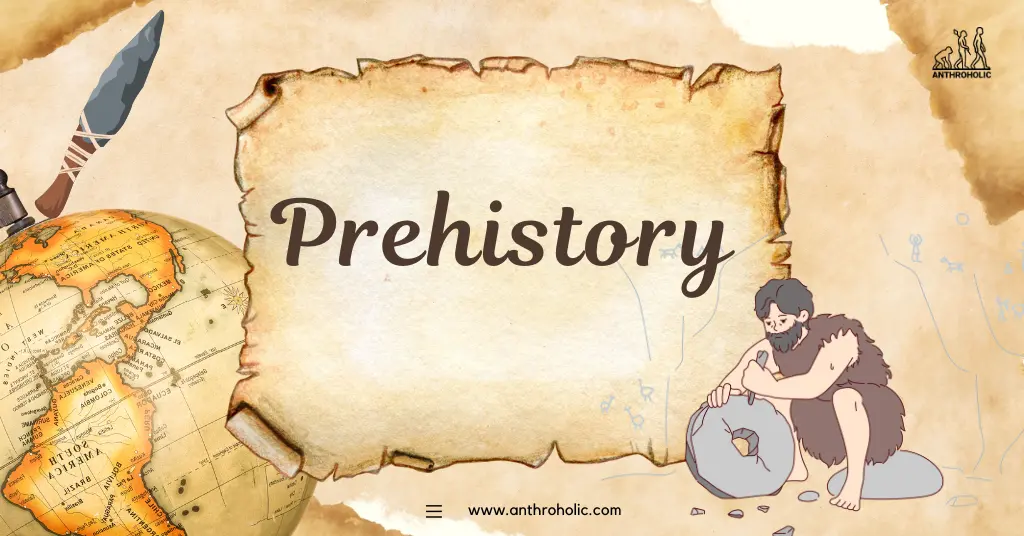AI Answer Evaluation Platform Live Now. Try Free Answer Evaluation Now
Prehistory
Prehistory is a period of human history before the advent of written records. It’s an era that set the groundwork for human civilization, full of intrigue, exploration, and adaptation.

Understanding Prehistory
Prehistory is divided into three main periods: the Paleolithic (Old Stone Age), the Mesolithic (Middle Stone Age), and the Neolithic (New Stone Age).
| Age | Period | Approximate Years |
|---|---|---|
| Paleolithic | Early | 2.6 million – 300,000 years ago |
| Middle | 300,000 – 50,000 years ago | |
| Late | 50,000 – 10,000 years ago | |
| Mesolithic | 10,000 – 5,000 years ago | |
| Neolithic | 5,000 – 3,000 years ago |
Each age signifies distinct technological and social changes which shaped the evolution of mankind.
Paleolithic Age
Often referred to as the Old Stone Age, this period is characterized by:
- The use of stone tools by hominids, starting with the earliest known tools known as the Oldowan industry, discovered in East Africa [1].
- The emergence of Homo Sapiens and their spread around the world.
- The development of early artistic expressions, like cave paintings and sculptures [2].
Mesolithic Age
The Mesolithic age marks a transitional period where humans developed:
- More advanced, smaller stone tools, such as microliths [3].
- An increasing reliance on fishing and hunting for subsistence due to climate changes.
- Semi-permanent and permanent settlements as they became more sedentary.
Neolithic Age
The Neolithic Age is significant due to:
- The advent of agriculture, leading to the cultivation of plants and domestication of animals [4].
- Establishment of settled communities and the development of social organization.
- Development of pottery and more advanced tools, such as polished stone axes.
Significance of Prehistory
Understanding prehistory is paramount as it shapes our understanding of human evolution. The key areas of influence include:
- Technological Advancements: Tracking the development of tools helps us understand the ingenuity and adaptability of early humans.
- Cultural Developments: Art and symbols from prehistoric times provide insights into the thought processes and societal structures of early humans.
- Biological Evolution: Fossil records and genetic studies help trace the lineage of Homo Sapiens and their migration patterns [5].
The Interplay of Prehistoric Human and Environment
Paleolithic Interactions
During the Paleolithic age, humans lived in small, nomadic groups, exploiting the environment around them for survival:
- They hunted large game animals and gathered edible plants, adapting their diet according to the season and local availability [6].
- Paleolithic humans also developed simple clothing and shelter, usually using animal hides and natural formations, to protect themselves from harsh weather [7].
Mesolithic Adaptations
In the Mesolithic period, humans became more sophisticated in their environmental interactions:
- They began to master the art of fishing, often using boats and harpoons, in response to post-Ice Age rising sea levels [8].
- The use of fire became more controlled, leading to better cooking techniques and providing safety against wild animals.
Neolithic Innovations
With the advent of the Neolithic Age, humans began to significantly transform the environment:
- The practice of agriculture led to the clearing of vast areas of land for farming [9].
- Domestication of animals not only provided a reliable food source but also helped in farming and transportation.
- Humans began to build permanent settlements, leading to the formation of villages and eventually towns and cities.
Prehistoric Art and Symbolism
Prehistory also saw the birth of human creativity and symbolism. Cave paintings, petroglyphs, megalithic structures, and portable art are significant expressions of prehistoric art:
- Cave paintings, like those found in Lascaux and Chauvet in France, depicted animals, human figures, and abstract signs [10].
- Megalithic structures, such as Stonehenge in England and Carnac in France, showcase prehistoric engineering skills and potentially religious or astronomical uses [11].
- Venus figurines, small statuettes depicting women, found across Europe, are believed to be linked to fertility rites.
Prehistory: The Cradle of Civilization
Indeed, prehistory laid the groundwork for human civilization. Though the challenges of studying this era are immense, the potential insights we can gain about our past are invaluable. The rise of Homo Sapiens, our adaptations, creativity, and survival strategies reflect a fascinating tale of human resilience and ingenuity.
Research Methods in Prehistory
The study of prehistory involves multiple disciplines such as archaeology, anthropology, and geology. Key methodologies include:
- Excavations: Archaeologists dig sites to uncover artifacts and fossils.
- Carbon dating: This technique is used to determine the age of ancient artifacts and fossils.
- Paleoclimatology: Study of ancient climates helps to understand the environment in which early humans lived.
- Genetic studies: DNA sequencing provides insights into human evolution and migration patterns.
Challenges of Studying Prehistory
Studying prehistory comes with its unique set of challenges:
- Lack of Written Records: Everything we know is based on archaeological evidence and interpretations, which can be subjective.
- Fossil Record Gaps: Not all periods of prehistory are equally represented in the fossil record.
- Preservation Bias: Organic material like wood, bone, and leather do not survive well over long periods, leading to an over-representation of durable materials like stone and pottery in the archaeological record.
References
[1] Toth, Nicholas, and Kathy D. Schick. “The Oldowan: The Tool Making of Early Hominins and Chimpanzees Compared.” Annual Review of Anthropology, vol. 39, 2010, pp. 289–305.
[2] Chippindale, Christopher, and Paul S. C. Taçon. “The Archaeology of Rock-Art.” Cambridge University Press, 1998.
[3] Woodman, P.C. “The Mesolithic Period.” The Oxford Handbook of the Archaeology and Anthropology of Hunter-Gatherers, Oxford University Press, 2014.
[4] Bellwood, Peter. “First Farmers: The Origins of Agricultural Societies.” Wiley-Blackwell, 2004.
[5] Oppenheimer, Stephen. “Out of Eden: The Peopling of the World.” Constable, 2004.
[6] Richards, M.P. “A brief review of the archaeological evidence for Palaeolithic and Neolithic subsistence.” European Journal of Clinical Nutrition, vol. 56, 2002, pp. 1270–1278.
[7] Gilligan, Ian. “Clothing and Modern Human Body Culture in the Upper Palaeolithic.” Cambridge Archaeological Journal, vol. 17, no. 3, 2007, pp. 211-235.
[8] Bailey, Geoff and N.C. Flemming. “Archaeology of the continental shelf: Marine resources, submerged landscapes and underwater archaeology.” Quaternary Science Reviews, vol. 27, no. 23-24, 2008, pp. 2153-2165.
[9] Barker, Graeme. “The Agricultural Revolution in Prehistory: Why Did Foragers Become Farmers?” Oxford University Press, 2006.
[10] Clottes, Jean. “Chauvet Cave: The Art of Earliest Times.” University of Utah Press, 2003.
[11] Parker Pearson, Michael. “Stonehenge: Exploring the greatest Stone Age mystery.” Simon & Schuster, 2012.




